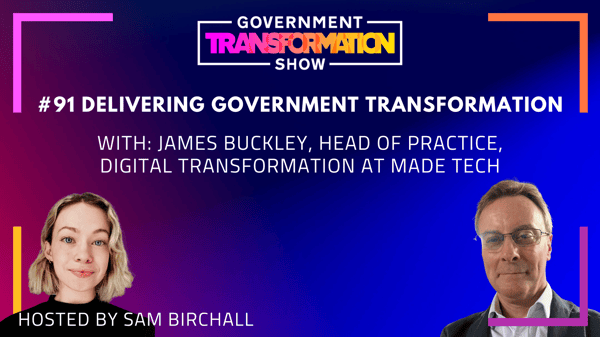Driving Transformation: Key Insights from Government Transformation Week
The recent UK Government Transformation Summit highlighted the significant gulf between citizen expectations and the current state of service delivery.
This disparity is fuelled by deeply ingrained challenges, including rigid governance and reporting structures, the need for extensive consensus-building across diverse stakeholders, inflexible budget cycles, and a reliance on cumbersome, monolithic solutions.

To overcome these obstacles and accelerate transformation, Government Transformation Summit championed three core principles.
Firstly, embracing composable architecture, where modular, reusable components can be readily assembled and reconfigured, allows for greater flexibility and speed in service delivery.
Secondly, acknowledging the relentless pace of technological change, the Summit advocated for perpetual evolution, fostering a culture of continuous improvement, agile methodologies, and ongoing adaptation.
Lastly, recognising that successful transformation requires bringing everyone along on the journey, Government Transformation Summit emphasised the critical role of change management, including clear communication, stakeholder engagement, and proactive address of concerns.
By embracing these strategies, the public sector can bridge the gap with the private sector, deliver exceptional citizen experiences, and fully leverage the potential of emerging technologies like AI.
Anchors to Transformation
Participants noted significant anchors that specifically impact public sector organisations, slowing transformation efforts and limiting the use of tools and methods being leveraged successfully in the private sector. In particular:- Governance / Reporting Requirements – The control and compliance policies and mechanisms in government organisations are there to reduce risk and ensure responsible use of public resources, but also constrain innovation and pace, and can add substantial overhead to programmes.
- The Need to Build Consensus – Unlike most commercial organisations, government bodies do not operate in a fully top-down manner. Initiatives require consensus across various stakeholders, with buy-in from different functional leaders and across multiple levels of the organisation.
- Budget Lifecycle – The inherent nature of spending requests in UK government means agencies have to plan and design for 3-5 years, limiting their agility and increasing risk and complexity for transformation initiatives. Yet, to be effective in executing their various missions, organisations need a lever if priorities or policies change during the year.
- Monolithic Solutions – Public sector organisations tend to gravitate towards monolithic systems, of both the commercial-off-the-shelf variety and custom-built. These offer the benefits of scale and confidence, but tend to be “clunky” and are associated with long procurement processes.
Consequently, despite measurable gains in recent years, the technology landscapes of public sector tend to lag behind those of their commercial counterparts, and are often bespoke and fragmented. Nevertheless, these anchors are not altogether blockers. Speakers at the Transformation Summit offered various tools to help work through these challenges and highlighted notable successes.
Composable Architecture: Modular, Self-Contained, and Reusable Capabilities Are Key
According to Gartner, “A composable enterprise is an organisation that delivers business outcomes and adapts to the pace of business change. It does this through the assembly and combination of packaged business capabilities (PBCs).” At Salesforce, we apply this concept to our own products, ensuring they provide the optimal value for a range of customers.
We refer to this concept as ‘Modifiable-off-the-Shelf’ or ‘MOTS’, in contract to Commercial-off-the-Shelf or custom-built solutions. This architectural paradigm provides the best value: templatised processes, interfaces, and data models offer an elevated starting point, but it can easily be contextualised for any customer with declarative capabilities.
Agencies should consider developing their own reusable and repeatable components, to leverage across multiple projects and applications. Treat these components as an extension of the toolkit that we provide you, and manage them as products.
The concept is similar to micro-service architecture for integrations and processes, but instead based on a declarative-first platform, rather than custom code which is typically used to build micro-services. Nearly all business requirements in government are still delivered through custom code, which is costly, slow and counterintuitively, often limiting in its nature due to amount of work required to build the foundations. Composable architecture offers a practical and sustainable solution to accelerate pace of delivery and better meet business requirements.
Perpetual Evolution: Set a North Star and Move Towards it Incrementally
This notion of modularity leads us to the next principle: Perpetual Evolution. If it wasn’t already clear, AI has left no doubt that the pace of technological change will continue to accelerate, both in frequency and scale of innovation.
It’s a reality that we can no longer ignore; the experiences and services offered by B2C companies will take off like a rocket, exacerbating an already wide gap between the public and private sectors. Not only do we need to find ways to catch up, but we need an entirely new paradigm that allows government to keep up with rapidly evolving citizen expectations and technology innovations.
The perpetual evolution mindset is about setting a goal and vision, and working towards it incrementally. James Walsh, the Comptroller of the U.S. Department of State, summed up the key benefit of this approach: “when things go wrong, you know where your North Star is” and are able to adjust course and keep working towards the goal.
Transformation efforts should not be viewed through an all-or-nothing lens, with progress achievable only with large projects and costly investments. Public sector organisations must redefine their technology operating models to support and facilitate continuous change (in requirements and in technology).
McKinsey refers to this as ‘Perpetual Evolution’, but it more widely referred to as ‘Continuous Improvement’. Nicshan Floyd, Deputy Director of Customer Experience Directorate at the U.S. Department of Homeland Security noted that his department took such an approach with tremendous impact, implementing a solution to pre-fill forms with information already known to one of the department’s agencies, rather than asking for the information again, saving an estimated 31 million hours per year.
This also means placing emphasis on experimentation, in the form of small Proofs of Concept (POCs) and Proofs of Value (POVs). Experiments help to baseline the time required for delivery of the overall capability and provide a better understanding of both value and risk levers.
On the face of it, rigid public funding and procurement policies seem to severely limit, if not outright block, a perpetual evolution approach. However, upon closer examination, there are no inherent blockers. It certainly requires a degree of creativity to make the two work together, but the good news is that this has already been solved in an analogous context.
The US government—specifically the Executive Office of the President— successfully changed their procurement approach for Salesforce services whereby they buy agile points from system integrators and apply them to new business requirements, but do so within the bounds of Federal Acquisition Regulation (FAR).
Change Management: Bring Your Stakeholders Along on the Journey
A key theme of the event was the importance of applying organisational change management practices to transformation efforts. A change management strategy and swim lane is often viewed as a nice-to-have in planning transformation efforts. Yet, the data shows that change management improves project outcomes. According to Prosci, a leader in the change management space and creator of the ADKAR methodology, found that projects that properly implement change management are:- 65% more likely to stay on schedule
- 71% more likely to stay on budget
- 88% more likely to meet objectives
Change management also means asking for feedback and addressing questions and concerns. It ensures the responsiveness of the transformation–staff starts feeling heard, their suggestions considered, and requests tend to be delivered faster. And it makes them more engaged, triggering a virtuous cycle of engagement and support for further transformation.
Walsh also emphasised the need to articulate “why it matters” for any transformation effort, setting a clear vision and communicating it. He suggested to “find all your stakeholders, get them on your team”. Such an inclusive, proactive approach is key to building early buy-in for projects and ensuring the solution meets the needs of all stakeholders. There will undoubtedly be detractors–those resistant to change, sometimes change of any kind–but Walsh advises that you “ignore critics unless they’re spoilers”.
The marginal investment in change management pays back in multiples. This will become all the more important with AI adoption: it’s new, it’s very different, it’s far more powerful, and it’s yet another innovation that makes some fear for their job security (albeit needlessly). At Salesforce we firmly believe that “Humans with Agents Drive Customer Success Together” and are delivering our AI solutions with this in mind.
The Way Forward
.jpg?width=700&height=467&name=54155215185_c0a0cde1cd_o%20(1).jpg)
Andrew Western MP, Parliamentary Under-Secretary of State for Transformation, Department for Work & Pensions (pictured above) opened the day with a clear vision for improving services in the UK government, including revamped digital experiences, explicit focus on the vulnerable and disadvantaged, and responsive and accessible engagement.
The principles and practices that followed at the Transformation Summit offered public sector organisations the tools to achieve Western’s vision. While acknowledging continuing challenges, these frameworks offer a more efficient and effective path to meeting budget, scope, and timeline requirements and helping the public sector to bridge the gap with private sector when it comes to technology.
The advent of AI offers the potential to massively accelerate service delivery, through personalisation, proactivity, and automation, but public sector organisations need to take these foundational steps in order to capitalise.
Government also has the unique position of being able to freely share and collaborate, including functionality, design patterns, and experiences or practices. While there is a perceived uniqueness to each agency, there tend to be more commonalities with national peers and mission counterparts in other countries so there is no need to fully reinvent the proverbial wheel.
Industry players like Salesforce are also leaning into the concept of innovation partnerships, co-creating fit-for-purpose solutions for public sector customers in an incremental and iterative fashion, while also helping to shape product roadmaps.
Evidence from summit attendees showed clear desire for increased knowledge sharing and promotion of work between organisations, active sharing of successful services, and rapid test-and-learn mini-programmes.
The journey to transformation starts with practical steps and innovative partnerships. Ready to explore how your organisation can bridge the gap and drive meaningful change? Learn how Salesforce can help you accelerate your transformation goals by visiting our website.






